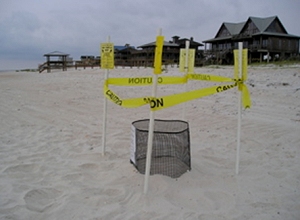Grant: 08-037R
Project Title: Mating System of Loggerhead Turtle (Caretta caretta) on St. George Island, Florida
Project Manager: Michael Gaines
Organization: University of Miami (Research and Educational Institute)
Grant Amount: $3,864.00
Completion Date: 2010-01-07
Summary: To address what factors may influence the frequency of multiple paternity (MP), the operational sex ratio (OSR: the average ratio of fertilizable females to sexually active males), and the potential reproductive benefits of MP, we have evaluated nests and collected tissue samples and weight measurements from hatchlings from 20 loggerhead nests on St. George Island (SGI), FL. As part of another related study, nest data and tissue samples have been collected from loggerheads in Quintana Roo (QR), Mexico. We will test the following three hypotheses and compare results from SGI with QR to strengthen our conclusions:
Hypothesis 1: The frequency of MP is associated with the abundance of females. We predict that the frequency of MP will be positively correlated with the abundance of females. Low abundance of individuals may lead to increased male competition and reduced male mating success.
Hypothesis 2: The OSR is correlated with the frequency of MP. We predict that the more the OSR is skewed towards females, the higher the frequency of MP will be as a result of lower male competition. Loggerheads may display competitive and dominant behavior as is observed in male green turtles.
Hypothesis 3: Mothers of clutches with MP have higher reproductive success than mothers of clutches with single paternity. We predict that females who mate multiply will better avoid inbreeding and genetic incompatibility and will produce hatchlings with increased viability by selecting higher quality sperm (though post-copulatory mechanisms), producing offspring with greater fitness. We will test the prediction by estimating reproductive success using clutch size, hatching rate, and hatchling weight and comparing clutches with and without MP. Results: All tissue samples and nest data have been collected. DNA has been extracted from all samples, which have subsequently been genotyped at 10 microsatellite loci, and results have been analyzed. This project comprises part of a chapter of J. Nielsenís dissertation, which is currently being written and prepared as a manuscript for publication.
Results: All tissue samples and nest data have been collected. DNA has been extracted from all samples, which have subsequently been genotyped at 10 microsatellite loci, and results have been analyzed. This project comprises part of a chapter of J. Nielsenís dissertation, which is currently being written and prepared as a manuscript for publication.